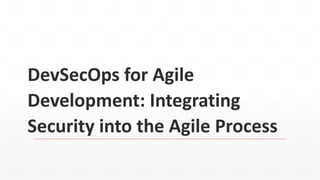DevSecOps for Agile Development: Integrating Security into the Agile Process
- 1. DevSecOps for Agile Development: Integrating Security into the Agile Process
- 2. Introduction In today's fast-paced business world, organizations need to be agile to remain competitive. Agile development is a popular methodology that helps software development teams deliver high-quality products faster and more efficiently. However, with increased speed comes the risk of security vulnerabilities that can be exploited by attackers. That's where DevSecOps comes in. DevSecOps is the integration of security into the agile development process. It involves the collaboration between development, security, and operations teams to build security into every aspect of the software development lifecycle. By doing so, security becomes an essential part of the development process rather than an afterthought.
- 3. What is DevSecOps? The traditional approach to software development involved security being considered at the end of the development cycle or even after the product was deployed. This approach is no longer sufficient in today's threat landscape, where attackers are increasingly sophisticated and the cost of data breaches can be significant. DevSecOps helps address this challenge by integrating security throughout the development process. DevSecOps is a mindset and a cultural shift that promotes collaboration between teams and emphasizes the importance of security. It involves automating security controls and making security a part of the software development lifecycle.
- 4. Shift-Left Testing Shift-left testing is a method of testing that involves moving testing earlier in the development process. In traditional development processes, testing is typically done at the end of the development cycle. With the shift-left approach, testing is done earlier in the development process. This allows for quicker identification and remediation of security vulnerabilities. By testing earlier in the development process, you can catch security vulnerabilities before they become more expensive to fix. It's also easier to make changes and fixes when they are identified earlier in the development cycle. Shift-left testing involves testing during the planning phase, the coding phase, and the testing phase. This approach can help ensure that security is considered at every stage of the development process. Here are some ways to integrate DevSecOps into your agile development process:
- 5. Continuous integration and deployment (CI/CD) is a development practice that emphasizes the automation of the software build, test, and deployment processes. By automating these processes, it's easier to identify and fix security issues as they arise. CI/CD helps reduce the time and effort required to build and deploy software. It involves automating the build process, running automated tests, and deploying the software to production. By automating these processes, you can catch security vulnerabilities early in the development process and address them before they become more costly to fix. CI/CD also promotes collaboration between development, security, and operations teams. By working together to automate the build, test, and deployment processes, teams can ensure that security is integrated into every aspect of the development process. Continuous Integration and Deployment
- 6. Just like code, security can be automated and integrated into the development process. Security as Code involves creating security policies and controls as code, which can be tested, versioned, and deployed just like any other code. Security as Code helps ensure that security is considered at every stage of the development process. It involves creating security policies and controls as code and integrating them into the software development lifecycle. By doing so, security can be tested and deployed alongside the application code. Security as Code also promotes consistency and reduces the risk of manual errors. By creating security policies and controls as code, you can ensure that security is applied consistently across all environments. Security as Code
- 7. Threat Modeling Threat modeling is a proactive approach to security that can help identify potential security risks before they become an issue. It involves identifying the assets and resources that need protection, identifying the threats and vulnerabilities that could impact those assets, and then identifying and implementing countermeasures to mitigate those risks. By including threat modeling in your agile development process, you can ensure that security is considered early on in the development process. This can help you identify potential security issues and address them before they become more costly to fix.
- 8. Security Training Security training is an important aspect of DevSecOps. It involves providing training to developers, security professionals, and operations teams on security best practices, emerging threats, and the latest security technologies. By providing security training, you can ensure that everyone involved in the development process is aware of security risks and understands how to mitigate them. This can help reduce the risk of security incidents and ensure that security is considered at every stage of the development process. In addition to these strategies, there are several tools and technologies that can be used to support DevSecOps. These include:
- 9. Dynamic Application Security Testing Dynamic application security testing (DAST) involves testing the application while it's running to identify potential security vulnerabilities. DAST tools simulate attacks on the application to identify potential vulnerabilities and provide guidance on how to fix them.
- 10. Conclusion In conclusion, DevSecOps is a crucial approach for integrating security into the agile development process. By promoting collaboration between development, security, and operations teams, and automating security controls, security becomes an essential part of the development process. This can help ensure that security is considered early on in the development process and reduce the risk of security incidents.










